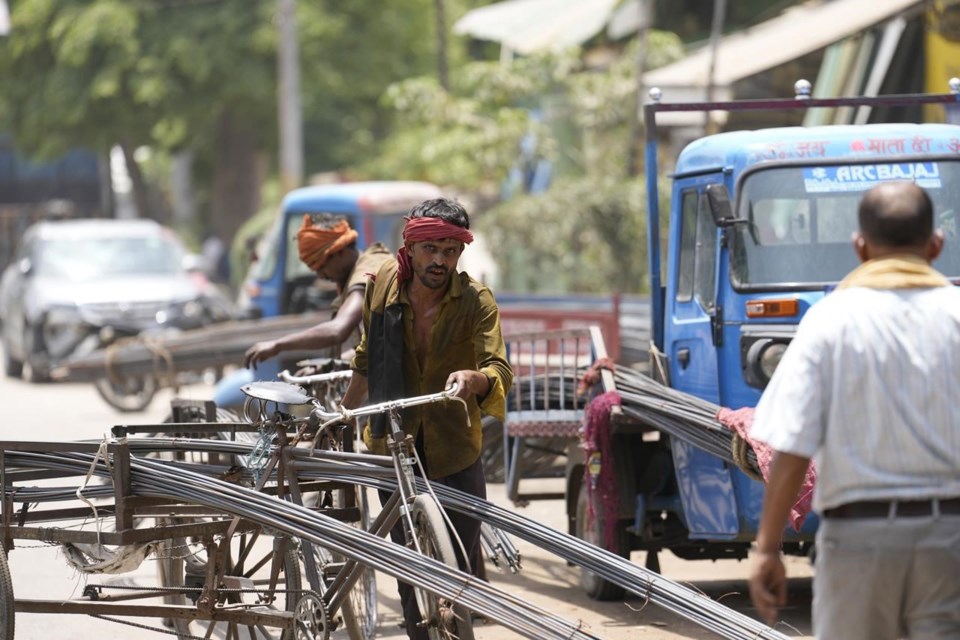LUCKNOW, India (AP) — Swathes of India from the northwest to the southeast braced for more scorching heat Monday, with New Delhi under a severe weather alert, as extreme temperatures strike parts of the country.
The Indian Meteorological Department issued a heat wave alert for seven southern and central states last week and broadened it to the capital and some northern states on Monday as sizzling temperatures breached normal levels.
It warned that blistering heat will continue for the next few days before rains bring some relief. The southwest monsoon is slightly delayed this year and will hit in the first week of June, causing temperatures to stay high longer than usual, it said.
As temperatures crossed 45 degrees Celsius (113 degrees Fahrenheit) in the northern state of Uttar Pradesh, some parts suffered blackouts lasting more than 12 hours despite a March order for all power plants in the country run at full capacity to reduce power cuts. The heat wave in the state is likely to continue for two more days, a weather official said.
Hundreds of frustrated residents protested outside power stations near the state capital, Lucknow, and blocked roads over the weekend.
“Power cuts mean no ACs, no fans, and even no water. The scorching heat has made our lives unbearable and the lack of power is adding to our misery,” said Ramesh Gupta, a Lucknow resident. He said his wife was forced to sleep in the car over the weekend with the air conditioning on high so their 9-month-old baby would stop crying.
The searing heat forced many residents of the city to seek refuge indoors. “We have become prisoners to the relentless summer as no one wants to venture out,” said Sudhir Sehgal, a teacher.
Sukhai Ram, a gardener who is paid only when he works, was forced to set down his tools. “I cannot work anymore now. I will work once the sun goes down,” he said, drenched in sweat.
Dairy workers wrapped their cans with jute to keep the milk from spoiling. Construction workers hosed themselves down for a temporary respite from the soaring heat.
Nighttime temperatures are also rising, sparking increased demand for electricity to run air conditioners and fans.
The main summer months — April, May and June — are always hot in most parts of India before monsoon rains bring cooler temperatures. But temperatures have become more intense in the past decade. During heat waves, the country usually also suffers severe water shortages, with tens of millions of its 1.4 billion people lacking running water.
A study by World Weather Attribution, an academic group that examines the source of extreme heat, found that a searing heat wave in April that struck parts of South Asia was made at least 30 times more likely by climate change.
The heat caused 13 people to die at a government event last month in India’s financial capital of Mumbai, and prompted some states to close all schools for a week.
Scientists say temperatures are at least 2 degrees C (3.6 degrees F) hotter in South Asia than in pre-industrial times because of climate change. Currently, the world is averaging about 1.1 to 1.2 C (2 to 2.2 F) warmer.
“Access to healthcare and to cooling solutions like fans and air conditioners is missing for a lot of the population in this region,” said Emmanuel Raju, director of the Copenhagen Centre for Disaster Research at the University of Copenhagen.
South Asia is considered among the most vulnerable to climate change in the world, according to various global climate studies. But India, the largest country in the region and the most populous in the world, is also currently the third highest emitter of planet-warming gases.
Scientists say drastic measures to reduce carbon dioxide emissions are the only solution.
“Heat waves will become more common, temperatures will rise even more, and the number of hot days will increase and become more frequent” if we continue pumping greenhouse gases into the atmosphere, said Chaya Vaddhanaphuti, a professor at Chiang Mai University in Thailand.
——
Arasu reported from Bengaluru.
___
Associated Press climate and environmental coverage receives support from several private foundations. See more about AP’s climate initiative here. The AP is solely responsible for all content.
Biswajeet Banerjee And Sibi Arasu, The Associated Press



